The latest Winter 2025/2026 snowfall predictions show an interesting picture, with a Stratospheric Warming event forecast to bring more snowfall than initially expected. Increased snowfall potential is forecast across several areas of the United States and Canada, with some snowfall increase also seen across Europe.
The main global weather driver in the upcoming winter season is expected to be La Niña. But in the past days, we have been tracking a developing Stratospheric Warming event, which will also impact the winter Polar Vortex and daily weather.
We will first quickly look at both weather drivers and their expected influence on the snowfall season. Then, you will see the latest snowfall predictions for the upcoming Winter and which areas across the United States, Canada, and perhaps Europe are forecast to benefit most with more snowfall.
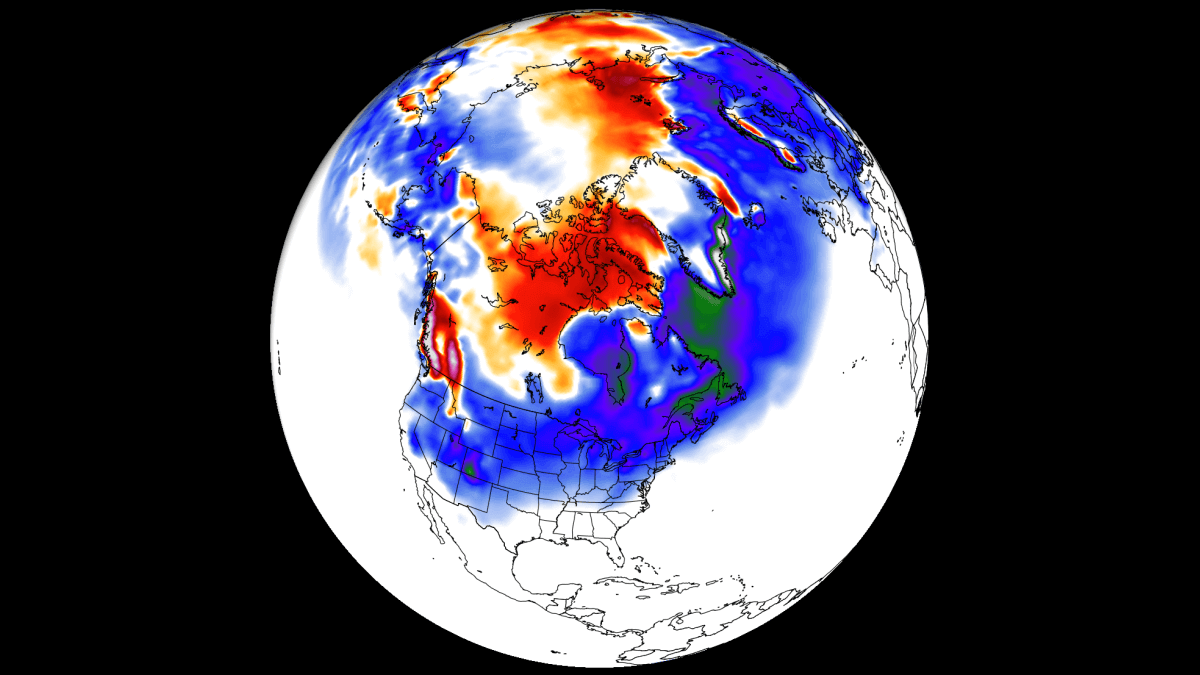
ENSO SEASONAL WEATHER INFLUENCE
The La Niña we mentioned is an ocean anomaly in the Pacific ENSO regions. This is a region of the equatorial Pacific Ocean that changes between warm and cold phases. Typically, there is a phase change around every 1-3 years.
ENSO phases have a significant influence on tropical rainfall, pressure patterns, and the complex exchange between the ocean and the atmosphere. The image below shows the circulation pattern of a cold phase, which is currently active.

With all this, the ENSO has a strong impact on tropical rainfall and pressure patterns, altering the atmosphere-ocean feedback system. This feedback system spreads ENSO influence globally, affecting winter temperatures and snowfall patterns.
Below is the latest surface analysis of the tropical Pacific Ocean, with the marked ENSO area. Cold ocean anomalies extend across the region, creating a cold wave structure due to the easterly trade winds. This is the currently active La Niña, which is still strengthening but is expected to stay within weak to moderate levels.

La Niña usually forms during strong trade winds, which can tell us a lot about the state of global circulation. This way, we can use these anomalies as an “indicator” to better understand the current state of the global climate system and what to expect in the seasons ahead.
Below is a long-range ensemble forecast for the main ENSO region. The average forecast from the calculations falls within the cold phase area. This clearly shows that the La Niña will impact the 2025/2026 winter, but that’s as far as it will go, with an El Niño on the horizon for 2026. Forecast by ECMWF
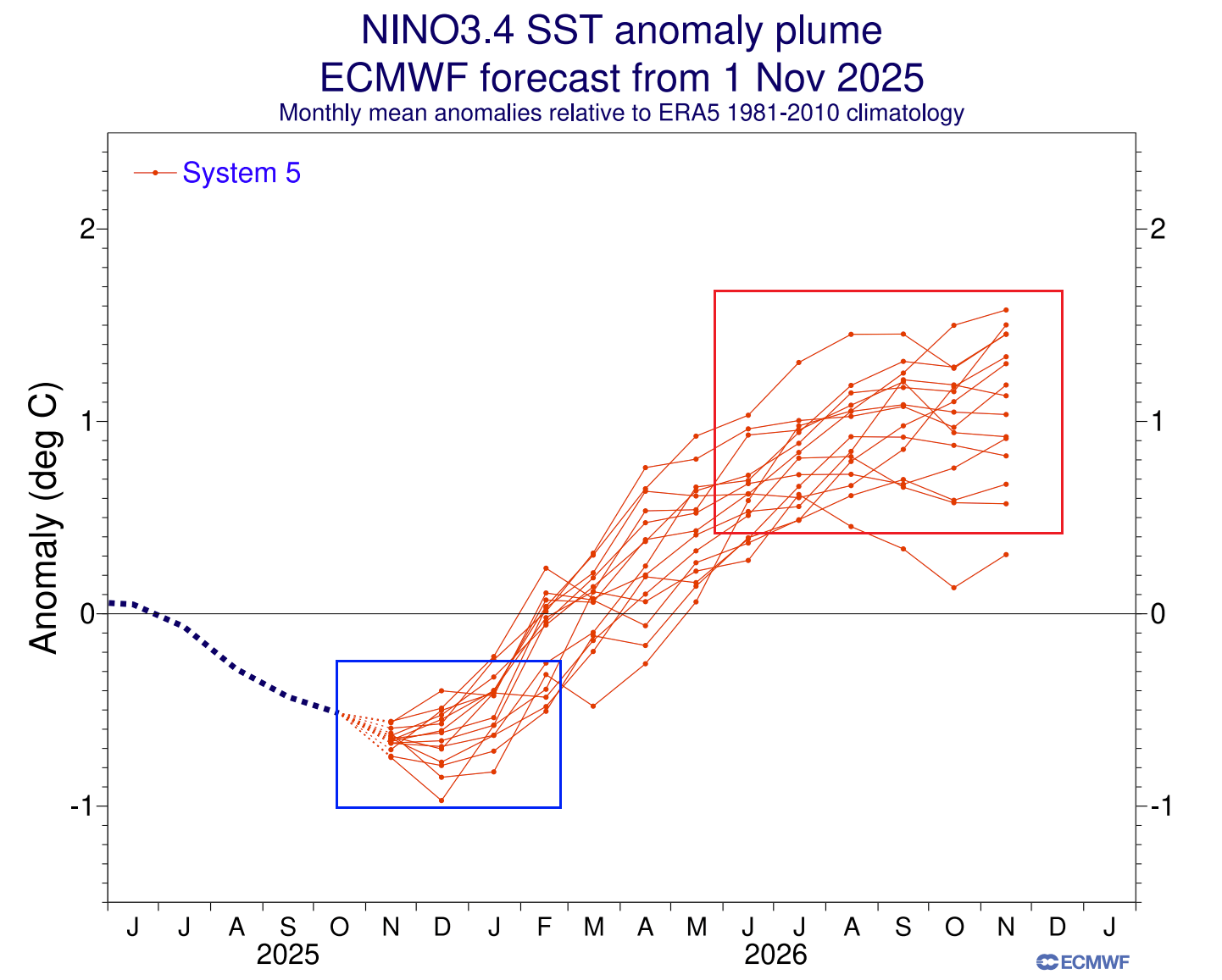
To better understand these ocean temperature changes, we produced a video showing how La Niña anomalies form and evolve.
The video below shows developing cold ocean anomalies in the equatorial Pacific over the past 90 days. During this time, the trade winds were strengthening, increasing upwelling of deeper, colder waters and creating the now-visible surface cold anomalies.
So what exactly does this mean for the winter weather patterns and snowfall potential? We will take a closer look at the weather influence that La Niña usually brings over North America, where it has a more direct impact.
Europe is not known to have any specific/direct influences, as it is too far from the source. But that does not mean it has no impact.
La Niña does change the weather globally. But apart from the direct influence over North America and other regional areas, Europe has many other factors at play before any direct influence can spread so far away, like the Atlantic pressure patterns, for example.
NORTH AMERICA WINTER WEATHER SYSTEMS
Typically, the first influence of these ocean anomalies can be seen in the jet stream patterns changing. The jet stream is a large and powerful stream of air (wind) at around 8-11km (5-7mi) altitude.
Historically, a strong high-pressure system in the North Pacific is the most typical effect of a cold ENSO phase. That tends to redirect the polar jet stream down over the northern United States, bringing along a colder airmass.
You can see the jet stream redirection in the image below, which shows the average jet stream position in La Niña winters and the resulting weather patterns developing over the United States and Canada. Below you can see the high pressure in the North Pacific, pushing the jet stream upwards, creating a “slide” effect for the cold air.

The displaced jet stream brings colder temperatures and winter storms from the polar regions down into the northern and northwestern United States. Warmer and drier winter weather prevails over the southern states.
Looking at the temperature analysis for the weak La Niña winters, you can see the cold anomaly area under the jet stream in western Canada and the northwestern United States. A cooler area extends over the Midwest and down into the south-central plains and partially to the east.

Warmer-than-normal weather and mild winter conditions typically develop over the southwestern United States, parts of the eastern United States, and eastern Canada. This image also shows data from older winters, so it tends to look colder than more recent winters. But it does highlight the impacts and trends.
So, because colder air is more easily accessible to the northern United States, this increases the snowfall potential when moisture is available. In the graphic below, you can see the average snowfall pattern for La Nina years, as expected for this Winter season.
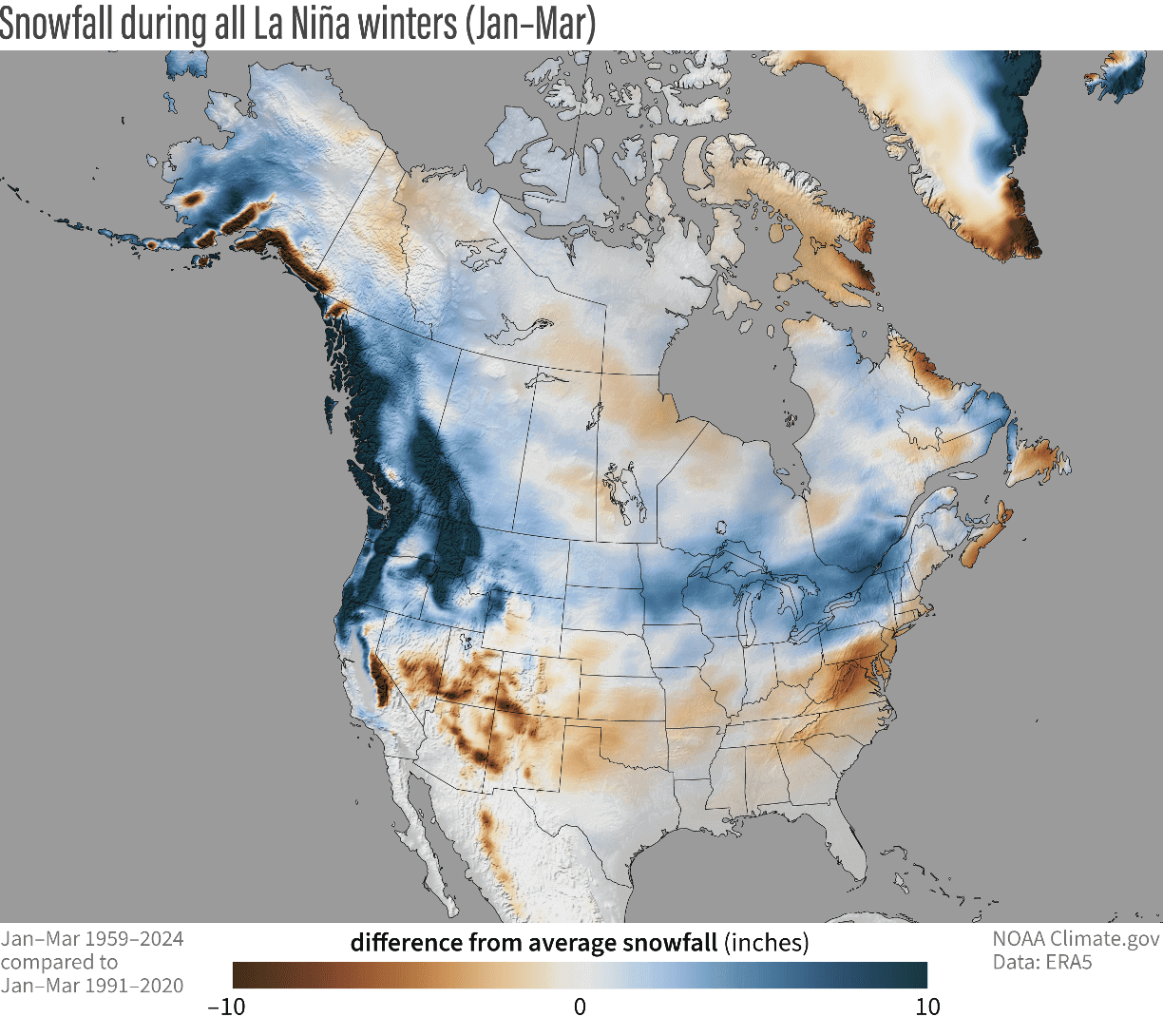
Besides western Canada, the northwestern United States, and the Midwest, you can also see more snowfall potential over parts of the northeastern United States and southeastern Canada.
But as mentioned in the intro, there is one more weather driver getting ready for the upcoming winter, and instead of being in the ocean, it’s actually much higher, up in the stratosphere.
STRATOSPHERIC WARMING SNOWFALL IMPACT
We are currently observing a rare early-season Sudden Stratospheric Warming (SSW) event in the atmosphere above us. This event is basically a rapid rise in temperature and pressure around the stratospheric Polar Vortex.
To understand the Polar Vortex, you don’t need to be an expert. It is a name that describes the whole winter weather circulation. It acts like a “wall” of lower pressure, spinning over and around the polar regions from the surface to the stratosphere (over 50km/30miles high), containing/locking the cold polar air inside.
During an SSW event, the Polar Vortex gets disrupted or even fully collapses. It then has a much harder time containing the cold air, which can now easily escape from the polar regions into the United States or other mid-latitude regions. Below is an example of how a disrupted Polar Vortex can help release cold polar air into the United States and Europe. Image by NOAA-Climate.
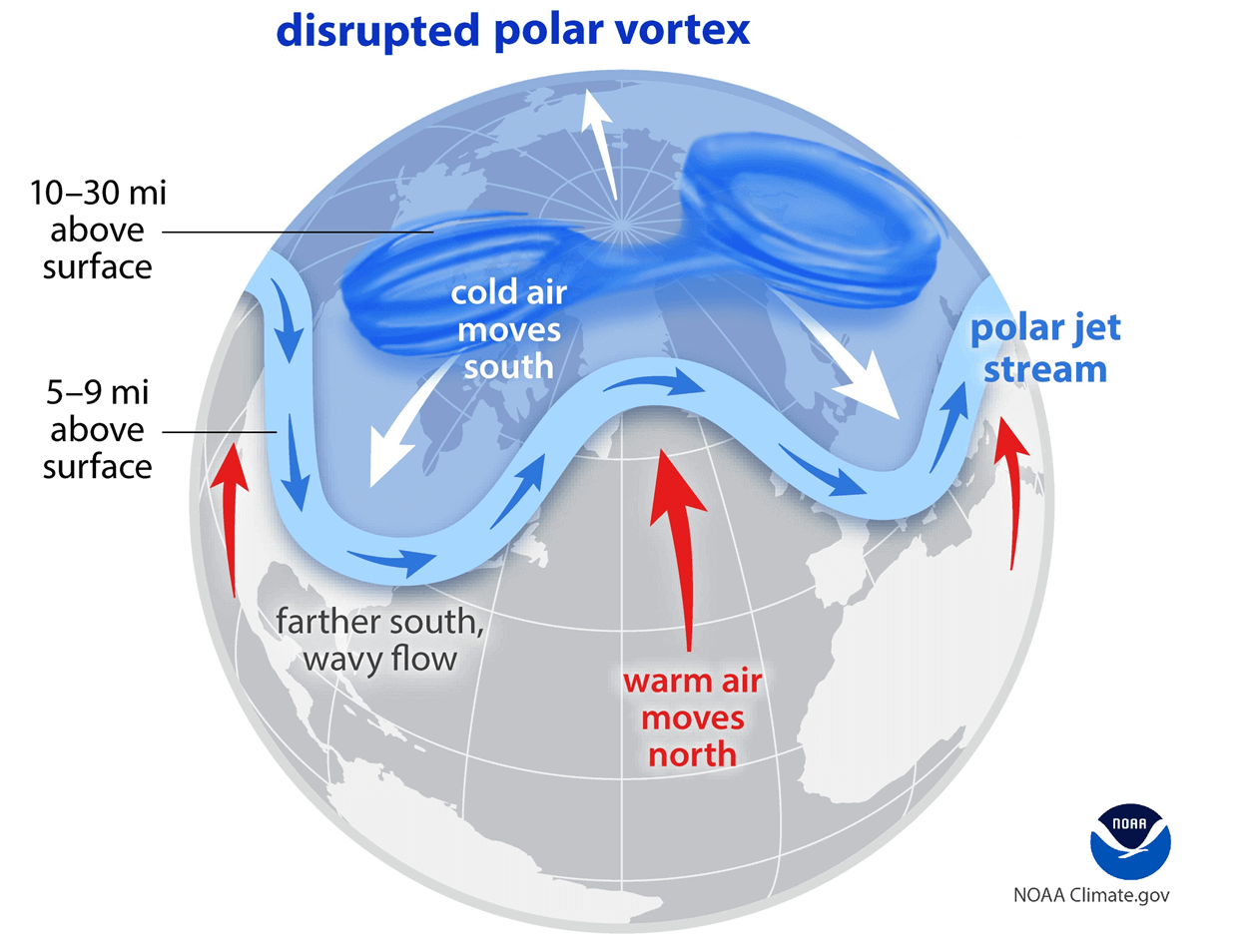
So if you want proper Winter weather with cold and snow, a weak/disrupted Polar Vortex is exactly what you want to see.
In the image below, you can see the SSW event forecast, with a high-pressure anomaly in the mid-stratosphere (30km/18.5miles height). This shows that the Polar Vortex is being displaced and compressed by the high pressure, creating a disruptive effect on the Polar Vortex and bringing weather effects down to the surface with a delay.
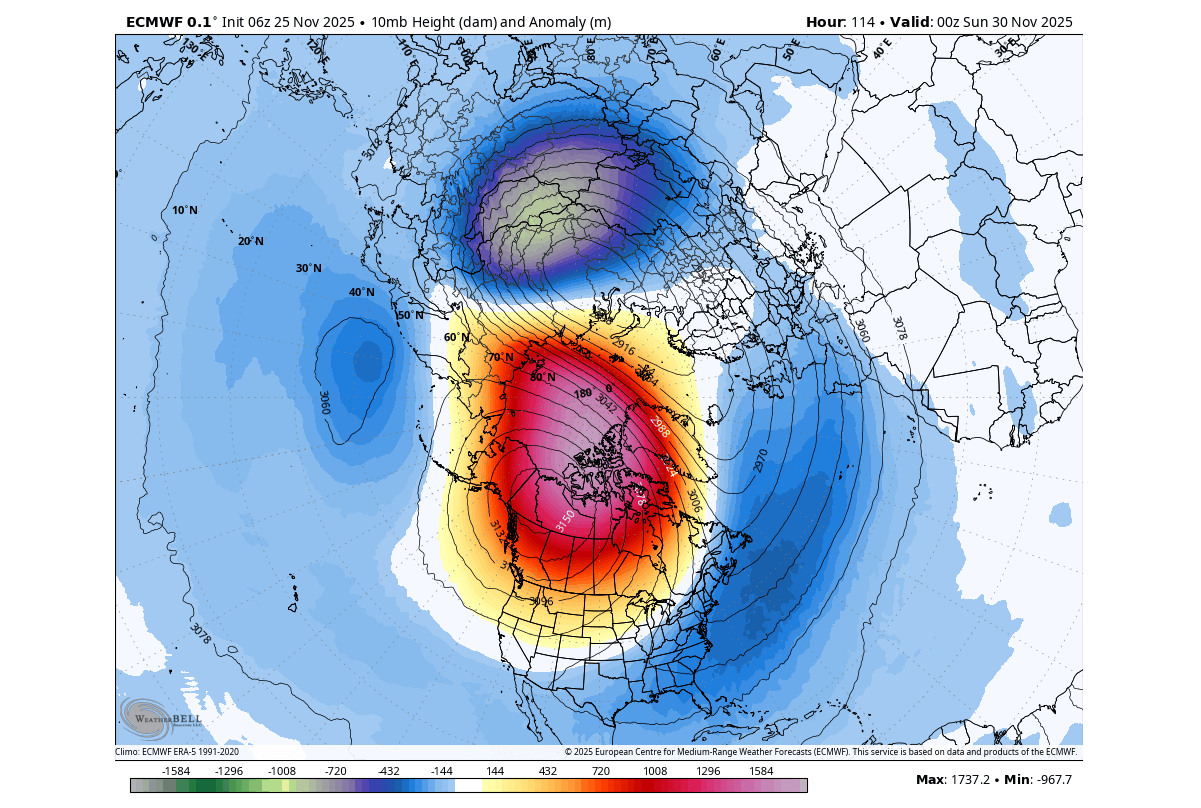
What is remarkable about this current stratospheric warming event is its timing. It is safe to say that it’s a very early event. In fact, we made a data reanalysis to find out how rare these events are in November.
We found only 3 stratospheric warming events that occurred this early in the season in the past 70 years. The seasons were 1958, 1968, and 2000, which had stratospheric warmings in November. Two of which had a full wind reversal, and with 2000 just a weakening similar to this year.
Below is the December surface temperature anomaly from PSL, following these stratospheric warming and Polar Vortex disruptions. It is very clear that such early events helped create a cold-weather corridor across Canada and the entire United States, except for the Southwest. Such a cold airmass is a clear factor to increase snowfall potential.
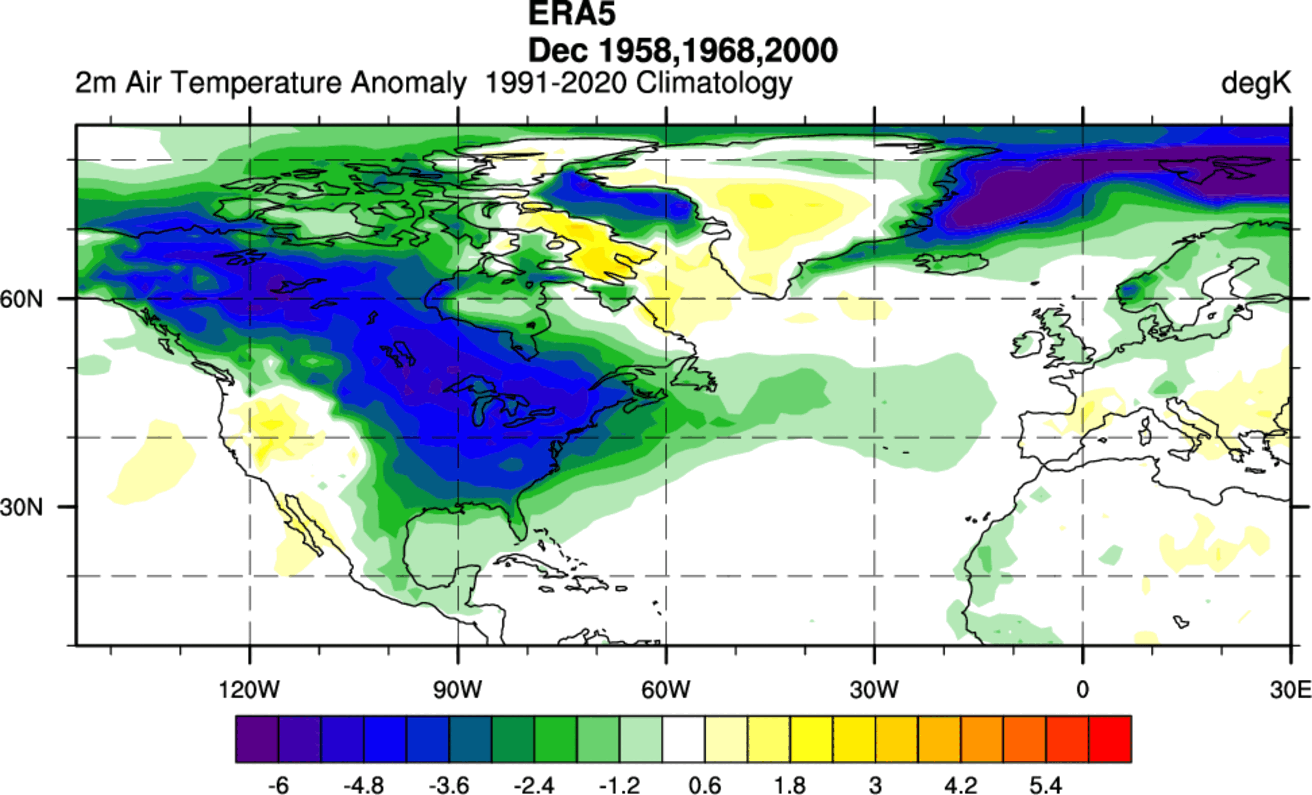
We are not sure why, but Europe shows a rather weak temperature response, with only some cooling evident over the northern and north-central parts. But we can still see a meaningful cold air coverage to the north.
Now, we will look at actual Winter snowfall predictions from the latest seasonal forecast models. And we will also compare the latest forecasts with previous runs to identify areas with increasing snowfall trends.
WINTER 2025/2026 LATEST SNOWFALL PREDICTIONS
The format of this forecast is simple. We will look at two well-established seasonal weather forecasting systems. First is the ECMWF, and then it is the UKMO. The data used to produce these graphics is from mid-November and is the latest available.
You will see the average snowfall forecast for the meteorological Winter season, covering the December-January-February period. We will also do a monthly breakdown, as there are a lot of details in the monthly forecast that the whole seasonal average cannot show.
First, looking at the seasonal average, we see below-normal snowfall across much of the continent, with the main snowfall areas pushed towards the north. But you can see some central and western areas that show a lower snow deficit.
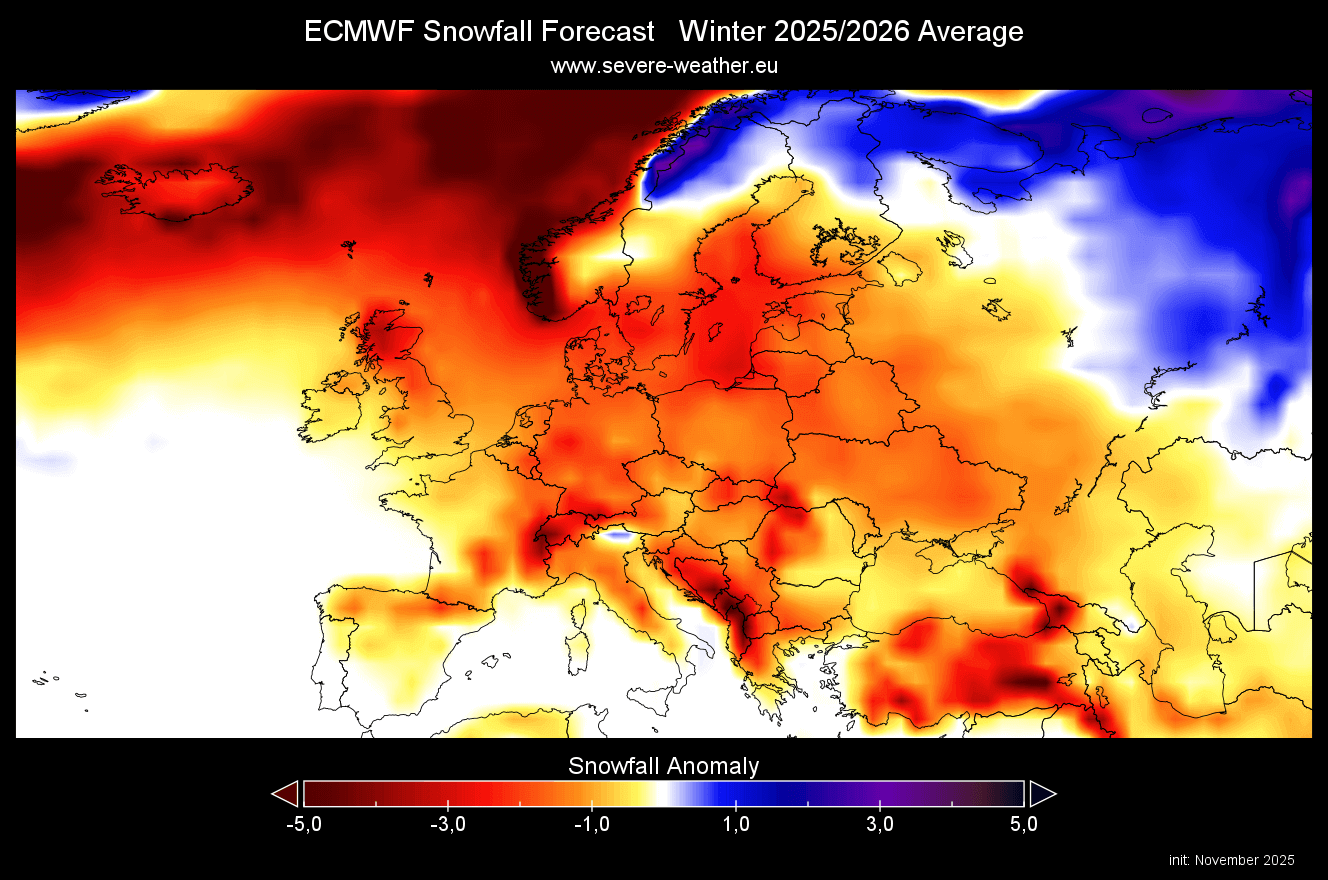
But compared to the forecast data from the previous month, there is some improvement. There is more snowfall now forecast in the latest data over central and west-central parts, and over parts of the UK and Ireland. We don’t see a wild snowfall increase as a result of the stratospheric warming, but the forecast is heading in the right direction with each new run.
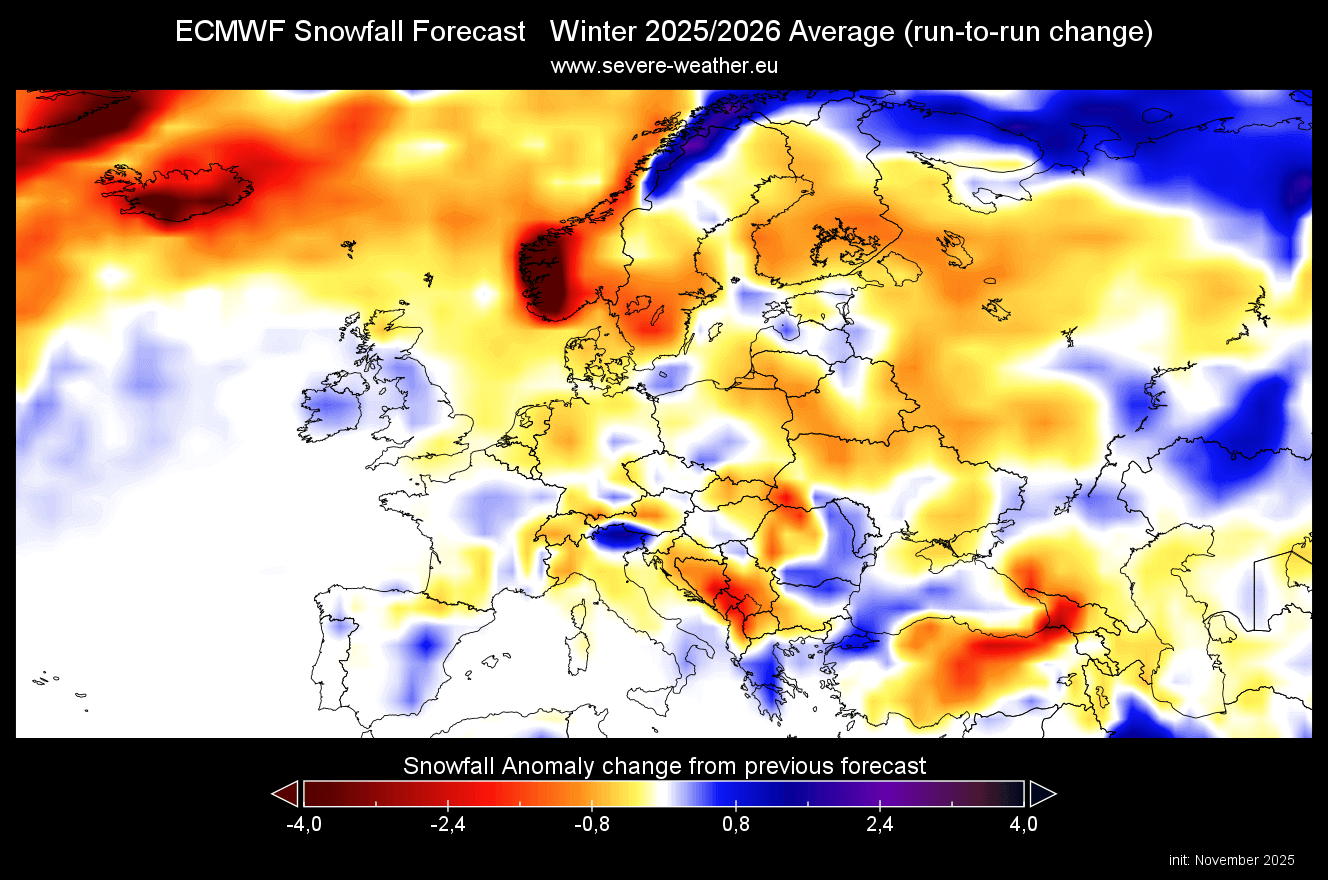
The December snowfall forecast shows mostly negative anomalies, apart from the far north. But we can see that apart from some stronger negative areas, there are zones with lesser deficits. It’s surprising to see less snowfall over higher elevations, indicating more of a low-precipitation problem, rather than warm temperatures.
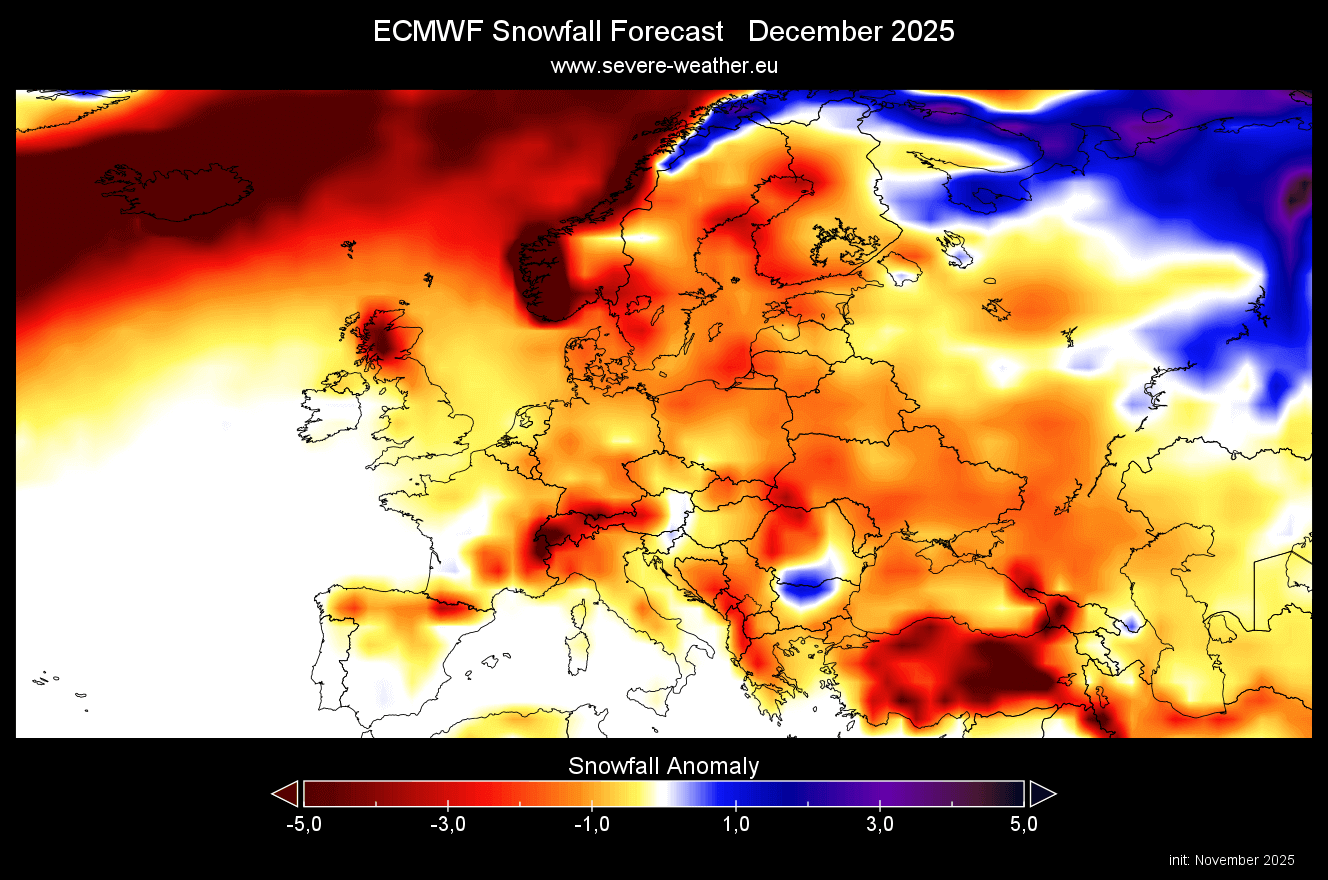
In the January forecast, we don’t see any improvement. Most of Europe is forecast to have less snowfall in mid-winter, but we do see some areas towards the southeast getting more snow in this period, along with far north.

The February forecast shows a bit less deficit compared to the January data. While both months look very poor with snow, the red color does not mean no snow at all. It just shows that less snow than normal is expected.
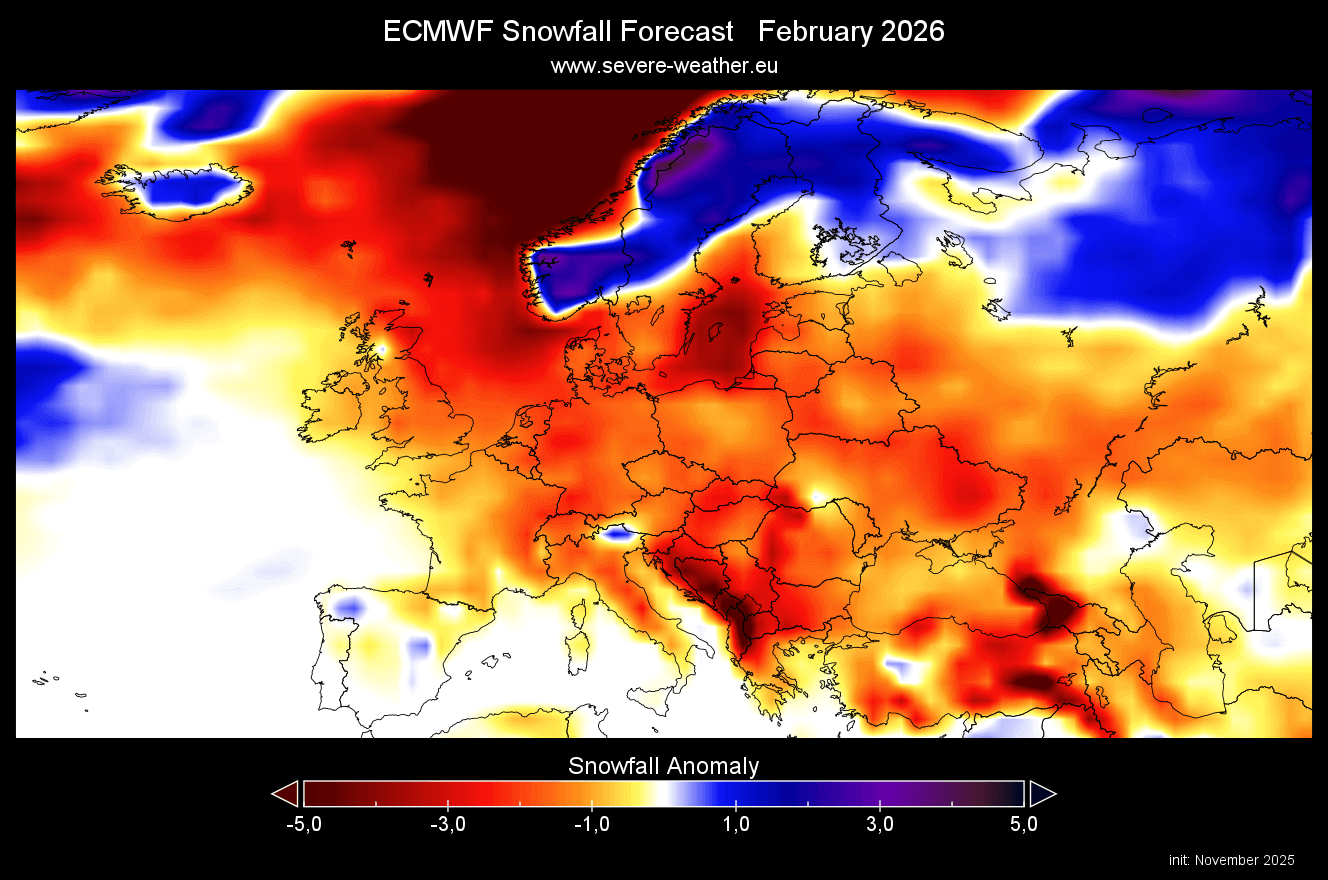
The March snowfall forecast covers early Spring and shows some potential for increased snowfall in parts of south-central Europe. We can also see a snow increase towards the southeast, and a deficit to the west. This would indicate a northern flow into the southeast and a warm southerly flow over the western parts.
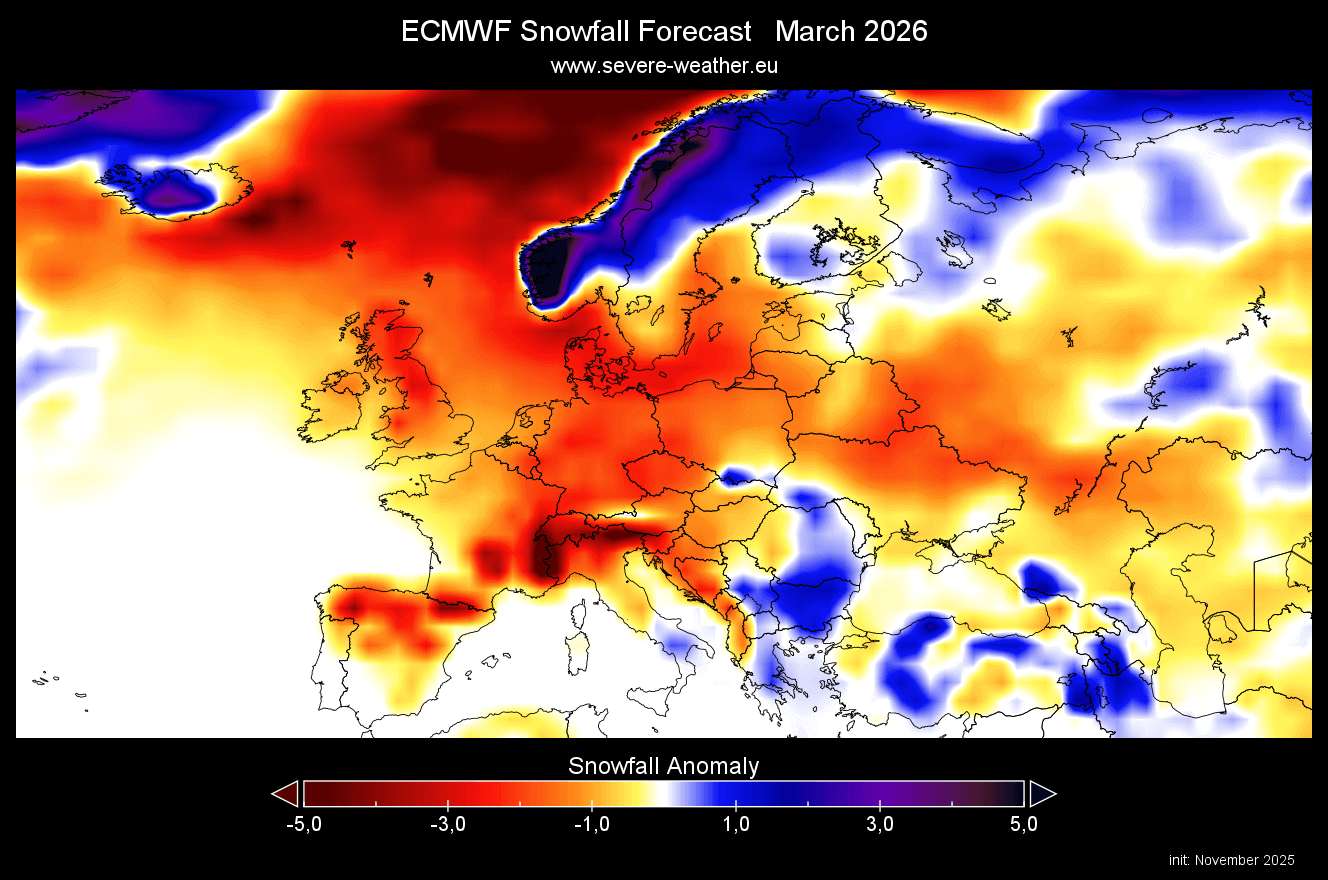
We also decided to add a new forecast graphic that shows the actual total snowfall. This comes in handy because it shows you actual snowfall amounts or the snowfall rate. From this forecast, you can actually see that there is some snowfall forecast across the wide region.

So what the snowfall anomaly images above mean is basically where we can expect to see more/less snowfall, compared to the long-term average.
NORTH AMERICA LATEST SNOWFALL PREDICTIONS
Over North America, the southern United States shows below-average snow depth over the entire Winter average. But the latest forecast below is starting to show more snowfall over the whole northern United States and the entire southern half of Canada. This can provide a substantial source of colder air over Canada and also a fixed corridor into the United States.

The deficit (or lack of) snowfall is less over the eastern and northeastern United States and over parts of the lower Midwest.
We can see this much better on the run-to-run comparison below. The latest forecast shows significant improvement, with more snowfall now forecast across the northern United States and the northeast, and also across the eastern United States and into parts of the south. This is something that we can expect to see after a stratospheric warming event, in the mix with ENSO and other tropical factors.

We can also see more snowfall in this forecast over the Pacific Northwest. But there are some areas with less snowfall in this run, like the southwestern United States, the central Plains, and, of course, eastern Canada.
The December snowfall forecast shows less snow cover over the southern parts of the United States. This month shows a substantial increase in snow coverage, with above-normal snowfall amounts forecast over the whole northern half of the United States, apart from the northeast. South Canada shows good potential, also thanks to the known impacts of the Polar Vortex in December, as seen earlier above.
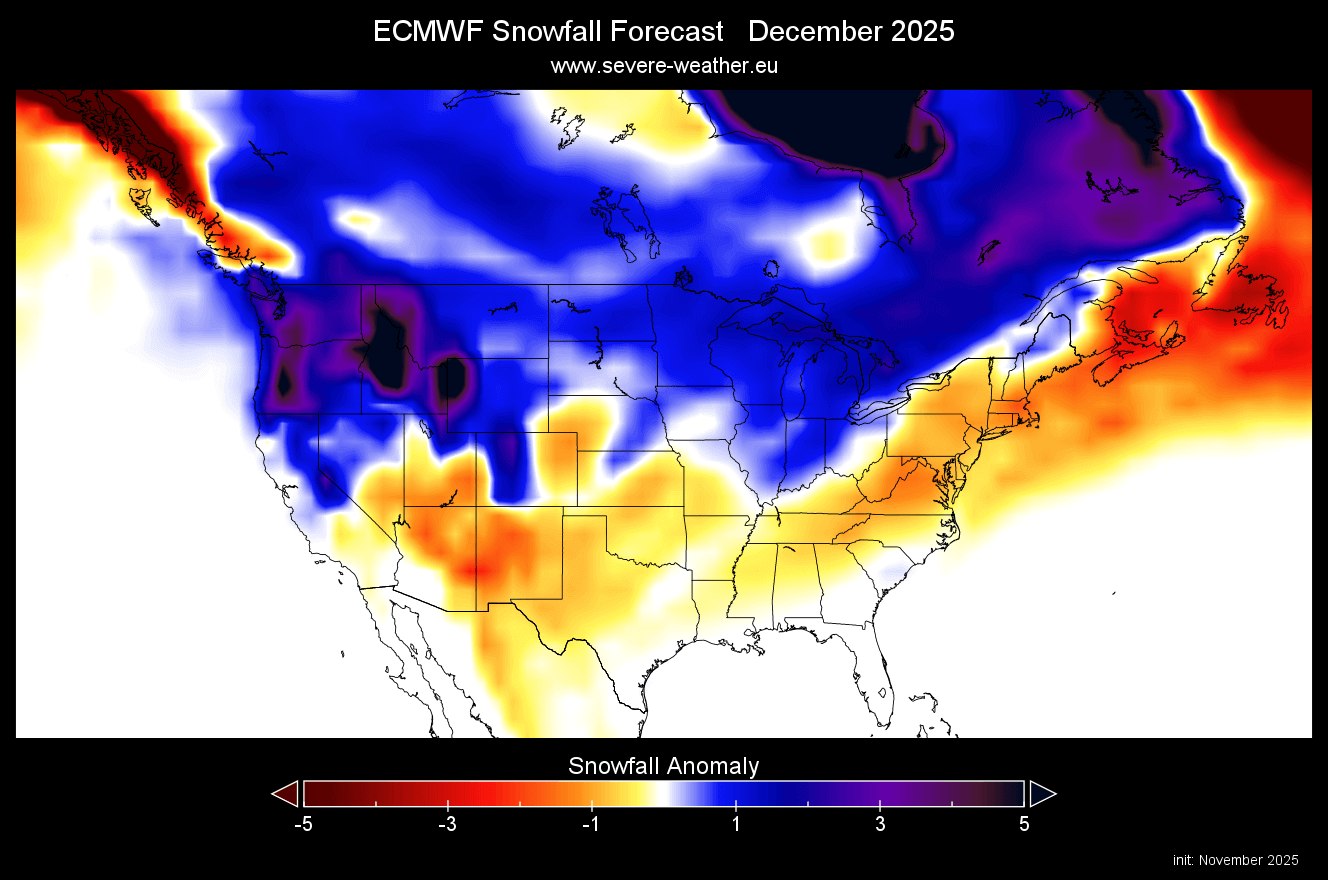
The January snow forecast shows more snowfall over the northern United States, the mid-Atlantic states, and Canada. Less snowfall is forecast over the south-central United States and over deep southeastern Canada. But we do see that the snowfall deficit over the eastern United States is much smaller than over California and the southwest overall.

The February snowfall forecast shows the main snowfall area to pull more to the north, looking to shift more into a La Niña-style winter. We see more snowfall over the northern United States and the upper Midwest, over the far northeast, and into southeastern Canada. This month is still far in the forecast range, so it can still start to increase the snowfall amounts with each run.

The March snowfall forecast shows the main snow area pulling back north slightly in early Spring, with a now stronger deficit seen over the Plains, the Midwest, and the northeastern United States. More snowfall is still forecast over southern Canada and into the northern United States.

On a side note (just as a fun observation), if you look closely at the image, you should be able to see a pattern of a cat crossing North America.
We were now looking at anomalies, which can only tell us so much. Below is the latest seasonal total snowfall forecast from ECMWF for the next month. It shows the total seasonal snowfall amount and shows legitimate snowfall even over areas that show a snowfall deficit for December.

But we do see a good amount of total snow forecast over the Midwest, the northeastern United States, and the West. It is also interesting to see snowfall reach far to the south, which could be a single cold event, but still leaves a mark.
This is a clear sign that while some areas show below-normal snowfall, that does not mean no snowfall at all. It just means those areas are expected to see less snowfall than usual, while still having some snow on the ground during the whole season.
UKMO WINTER 2025/2026 LATEST SNOWFALL FORECAST
Long-range weather forecasting is not easy, with a lot of factors that can impact seasonal weather. The more forecast data you can look at, the better idea you can get about the weather expected, as consistency is key, especially in weather forecasting.
And because you can never trust a single forecast model, we tend to use the UKMO long-range forecasting system as our second go-to choice. It is developed by the United Kingdom Met Office, which is where its initials come from.
First, looking at the seasonal average for Europe, we can see a rather weak snowfall forecast, similar to the ECMWF. Most of the continent is forecast to have a below-average snowfall season, except for the far northern parts. In our experience, UKMO tends to be less optimistic about snowfall than ECMWF, so this is to be expected.

The latest run shows much better snowfall amounts compared to the forecast data from the previous month. It is likely that some improvement comes from the current Stratospheric Warming event. Much of the mainland shows more snowfall in the latest forecast, and we can also see improved snowfall over the southern UK.
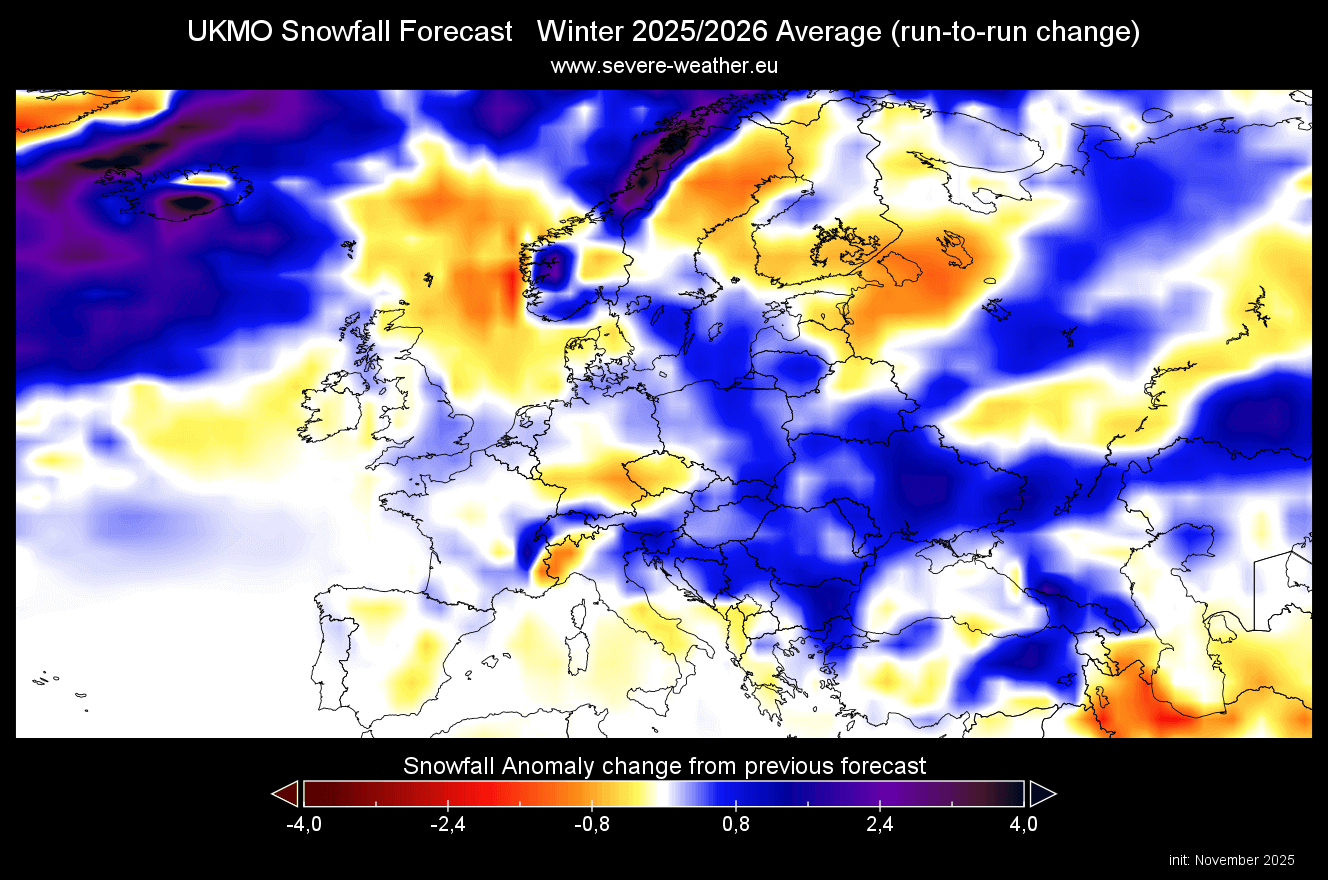
The December snowfall forecast shows stronger negative anomalies, just like the ECMWF. This agreement in both models does give some weight to this scenario, with a slower start to the snowfall season. There are still some south-central and northern areas with normal to above-normal or normal snowfall.

The January snowfall forecast shows some improvement in parts of central Europe, with even some above-normal areas, and lesser deficits over western parts. This suggests that the main problem this month is likely a lack of precipitation, along with milder temperatures.

The February snowfall forecast again reduces snow potential across most of Europe, except for the far north. We still see a lesser lack of snowfall compared to January, so it’s likely there would be more of a single-event snow drop, that’s still strong enough to o

Looking at early Spring with the March snow forecast, it shows a similar story to February. But it is starting to show some snowfall towards the southeast, similar to the ECMFW forecast. This indicates that both models see something in the same direction, which will reveal itself with new forecast runs.
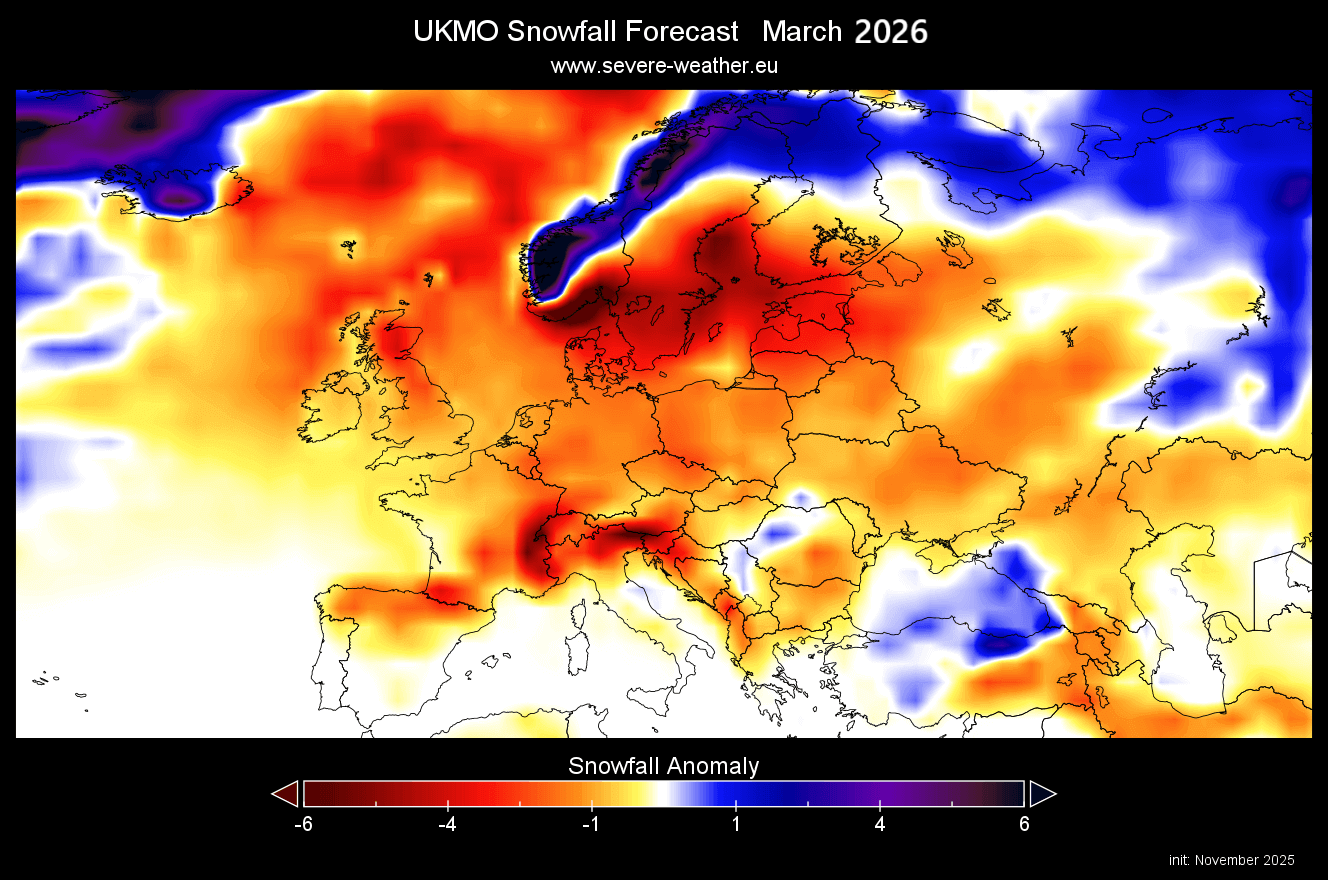
NORTH AMERICA UKMO SNOWFALL FORECAST
The average seasonal forecast for the United States and Canada shows a rather typical La Niña snowfall pattern. We see more snowfall forecast over the northwestern United States, the northern Plains, and the upper Midwest, and over much of Canada. Less snowfall is forecast over the central and southwestern United States, with the belt of less snowfall continuing to stretch towards the northeast.
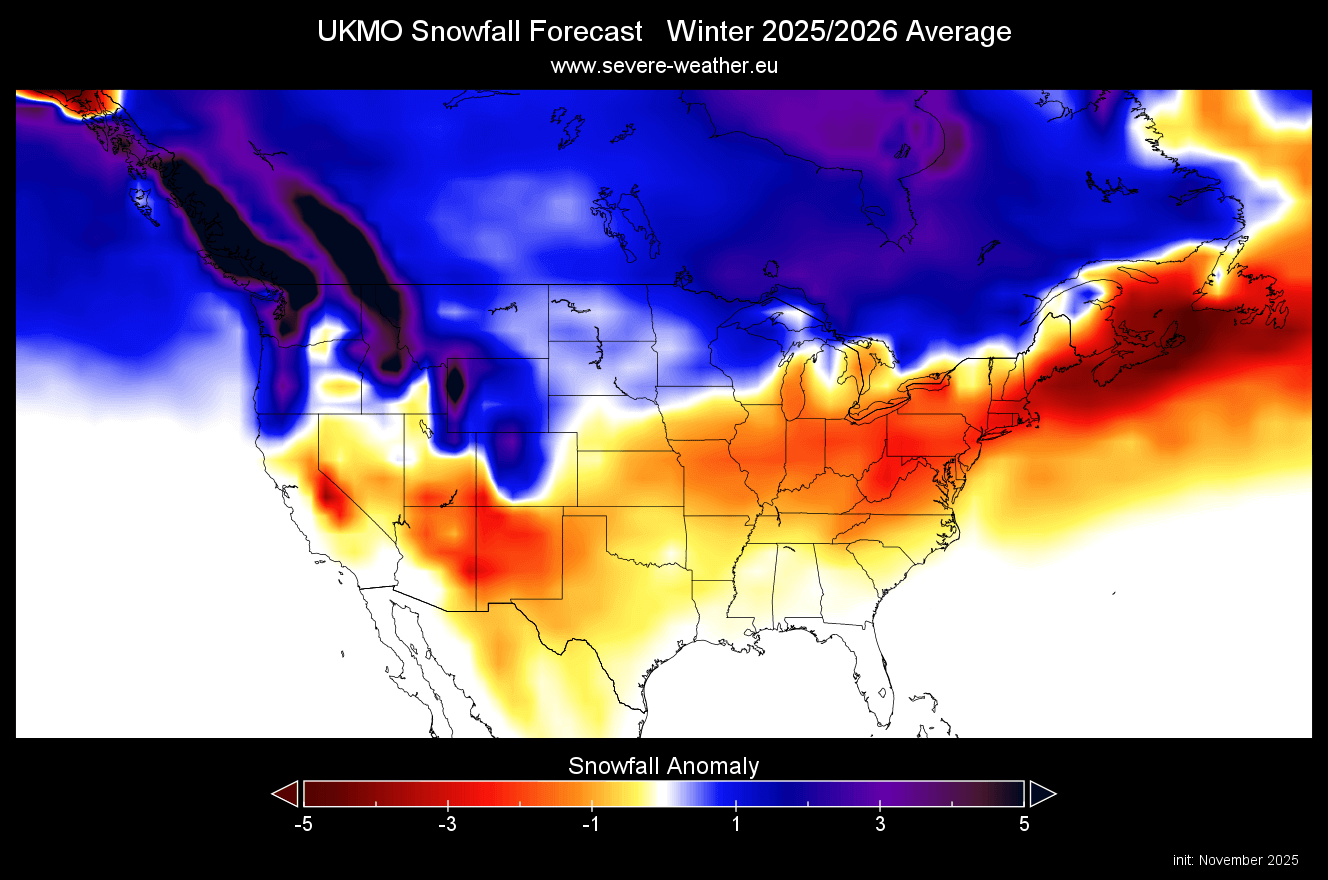
The UKMO shows a good improvement in snowfall amounts compared to the previous run. You can see more snowfall in the latest data over southeastern Canada, the central and western northern U.S., the southern states, the upper Midwest, and the northwest.
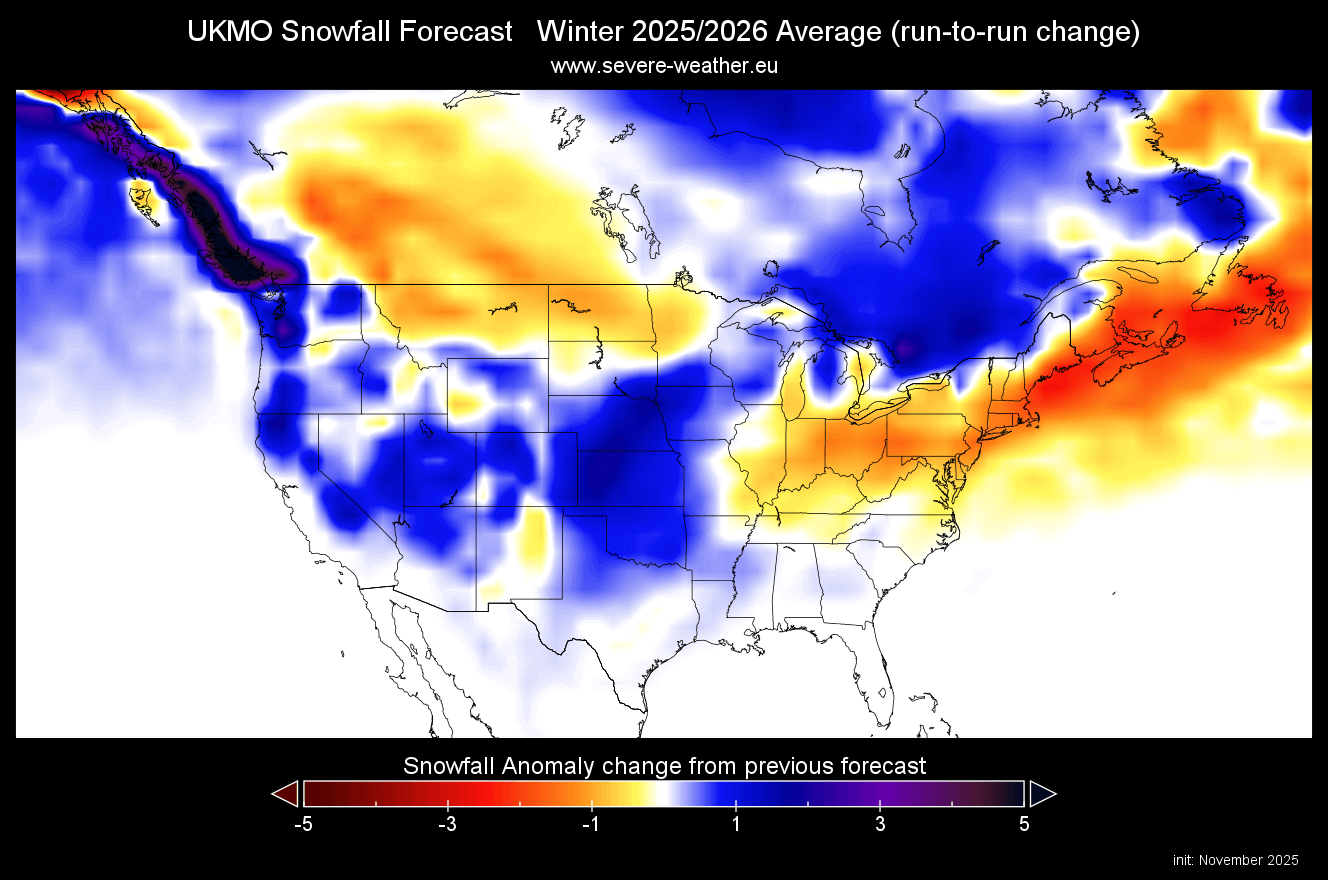
This model run also shows less snowfall over parts of the eastern United States, the northeast, and the far north.
The December snowfall forecast does not seem too optimistic at first glance. But despite less snowfall across the central and eastern United States, there is a larger pool of snow sitting in Canada. That means it is keeping the temperatures lower, so any cold air outbreak that comes from the north is generally colder than usual.
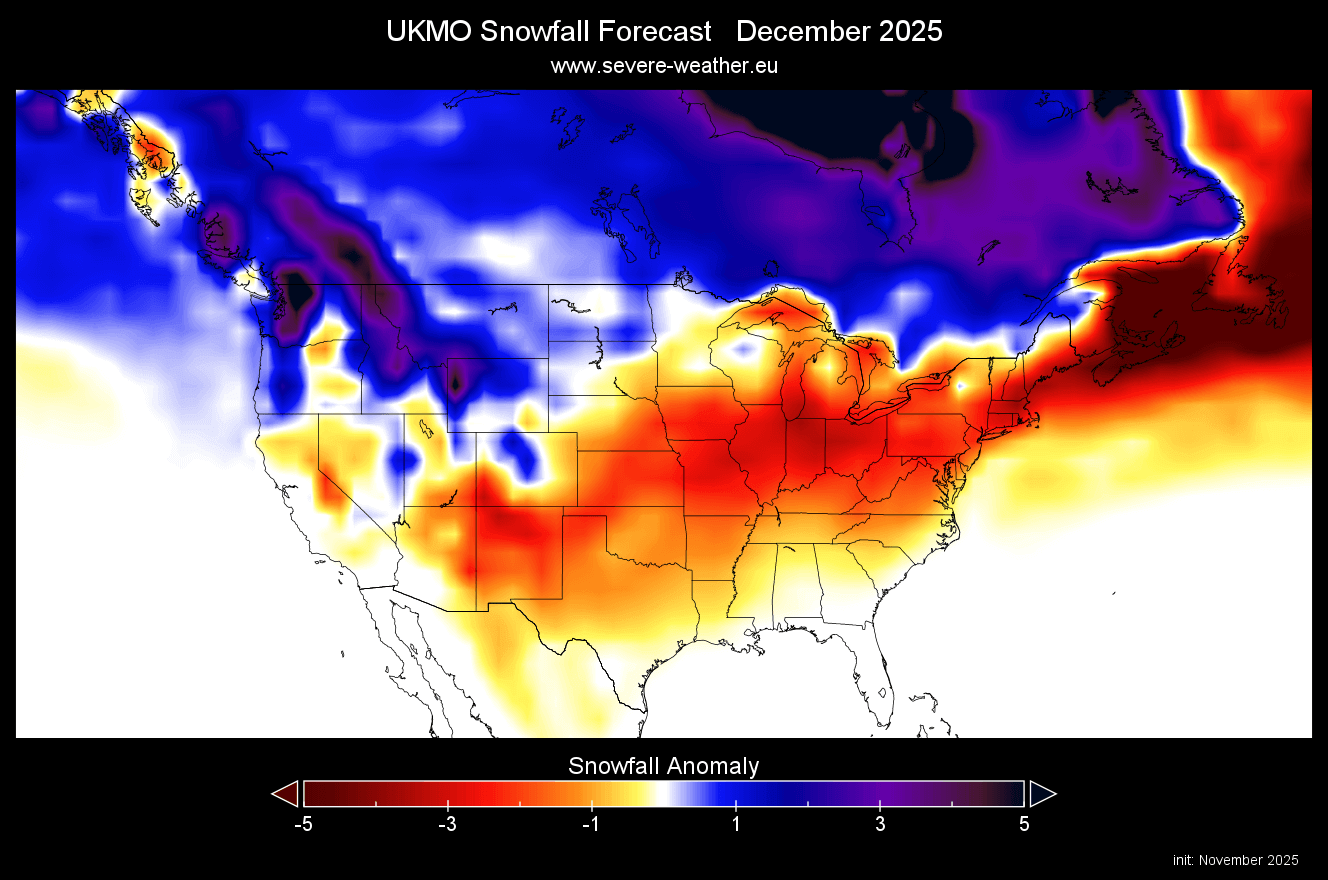
But for snowfall, we also need some precipitation. Overall, we do believe that this UKMO snowfall is not the most optimal, as we already have extended range forecasts that show a different story, combined with the stratospheric warming effect.
January snowfall forecast shows a better pattern across North America, with more snowfall over much of southern Canada and the northern United States. There is still less snowfall shown over the eastern United States, but we can see that the “lack” of snowfall isn ot as great as in December.

There is an interesting swath of snowfall going across the central to the southern Plains. Considering the amounts, this was likely done in a single event, leaving a mark on the monthly average.
The February snowfall forecast shows another improvement, with above-normal snowfall over much of Canada and the northern parts of the United States, the upper Midwest, and even over the southeast. The only real regions with below normal snowfall are the southwestern United States and the northeast in this forecast.

Otherwise, the rest of the country shows La Niña snowfall patterns, but the UKMO doesn’t seem to properly handle early-season stratospheric warming effects.
Looking at the latest March snowfall forecast, it shows continued snowfall potential over the northern United States and southern Canada in early Spring. The rest of the United States shows reduced snowfall amounts, and in a very (almost unrealistic) sharp pattern.
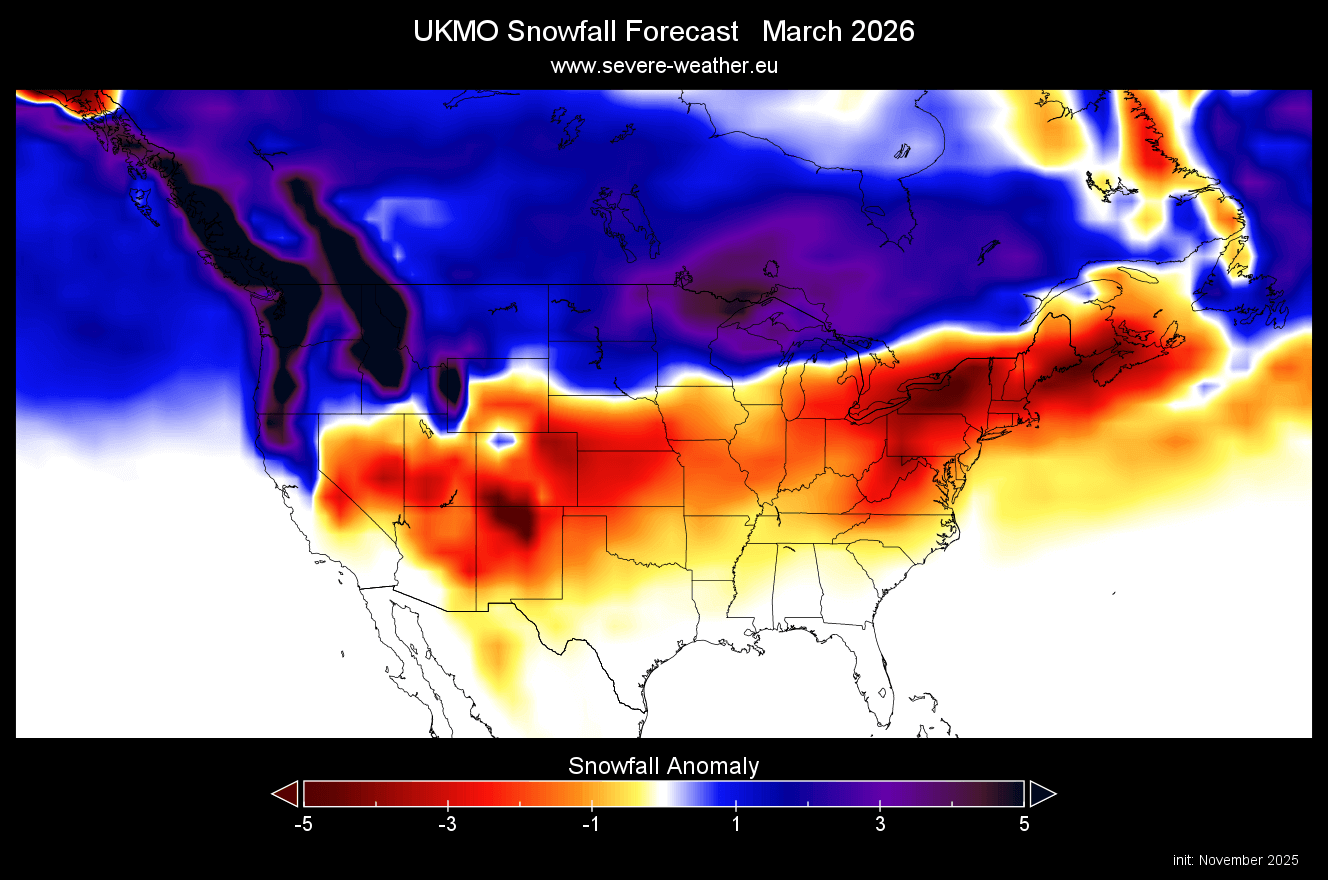
This shows a clear extended snowfall season over the northern United States. With a large mass of snow also in southern Canada, this will prolong the risk of cold air outbreaks into the United States well into Spring.
OFFICIAL WINTER 2025/2026 FORECAST UPDATE
We can also track snowfall potential by looking at the temperature and precipitation forecasts. The highest snowfall potential is usually found in regions where colder temperatures and more precipitation overlap.
We can see this in NOAA’s brand-new official winter temperature forecast for the United States. You can see colder-to-normal temperatures for most of the northern United States, extending into the south-central and northeast regions. The southern parts of the country and the east coast have a higher probability of warmer-than-normal weather.
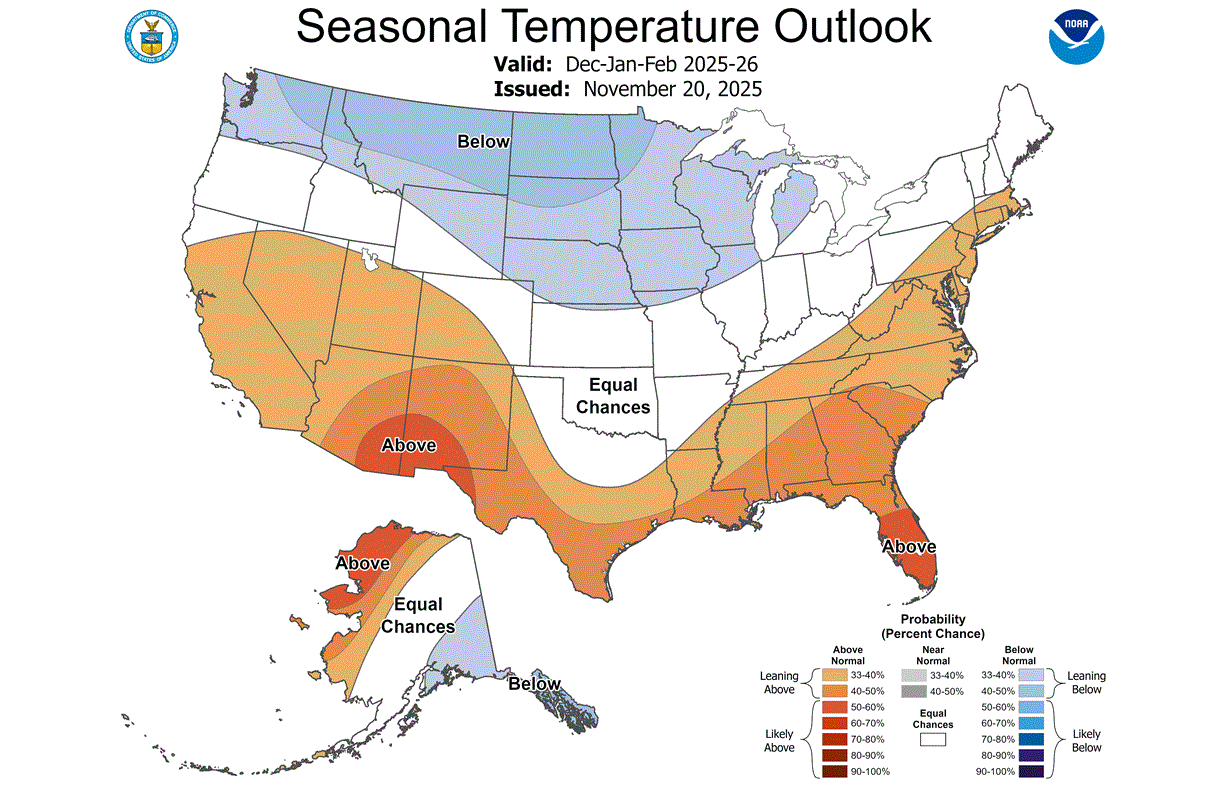
But note the trough of “average” temperatures extending into the southern Plains and the northeast. That can be interpreted as a likely route for winter cold-air outbreaks and potentially increased snowfall.
The official precipitation forecast shows quite a typical La Niña effect. More precipitation than normal (and snowfall if cold) is forecast over the northern half of the United States. The far southern United States is forecast to have a drier winter season.
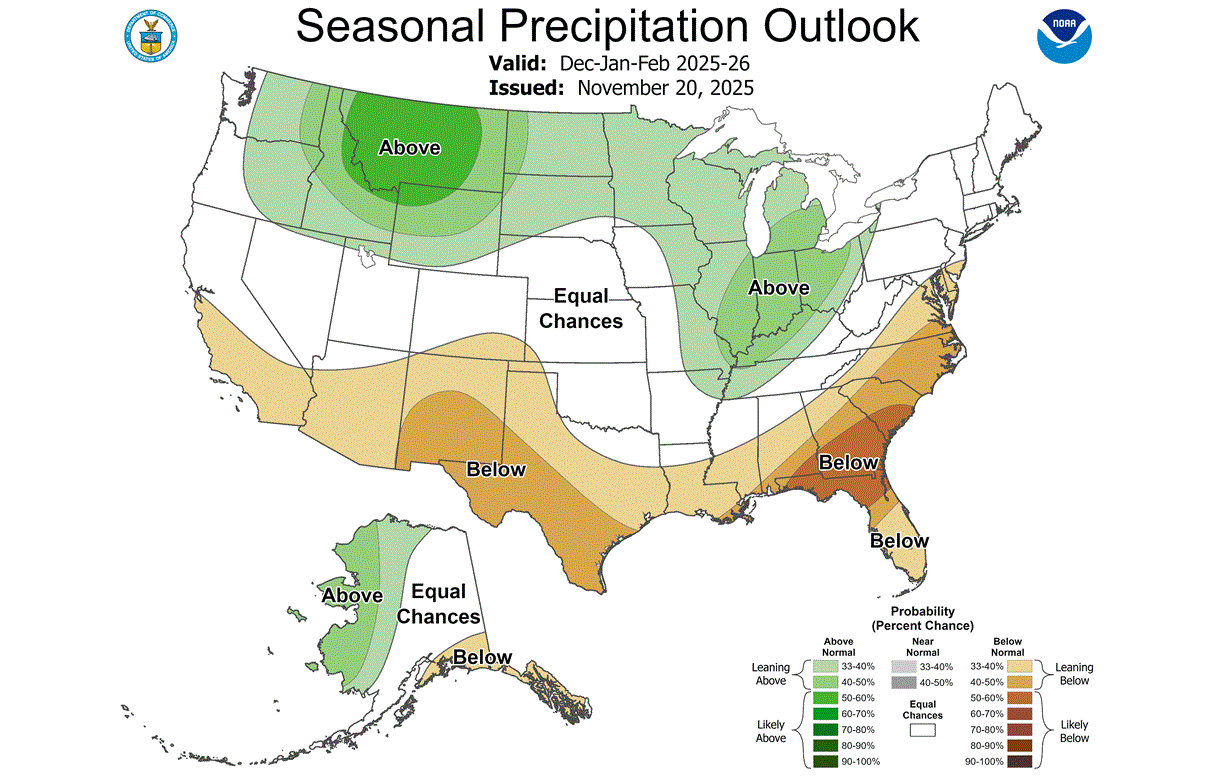
This also hints at increased potential for strong lake-effect snowfall around the Great Lakes during a cold air outbreak.
We will keep you updated on other developing weather trends, so don’t forget to bookmark our page. Also, if you have seen this article in the Google App (Discover) feed, click the like button (♥) there to see more of our forecasts and our latest articles on weather and nature in general.
Don’t miss: